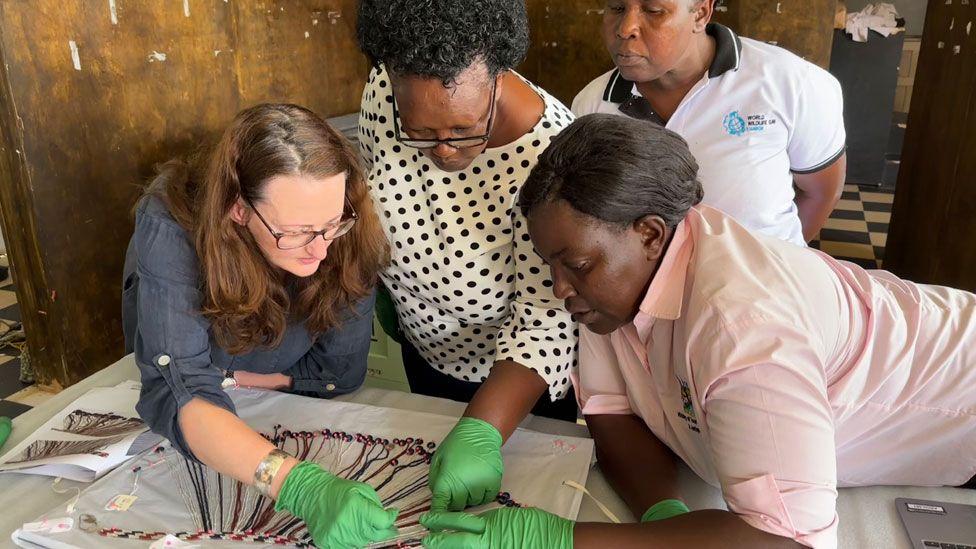In a groundbreaking exploration of the University of Cambridge’s collections, Dr. Eva Namusoke has identified around 350,000 items related to Africa, including artefacts, manuscripts, human remains, photographs, and natural history specimens. Her fifteen-month investigation involved extensive collaboration with librarians, curators, and archivists across various departments, revealing a wealth of materials that have largely remained out of public view. Despite the common practice among large museums of not displaying most of their collections, the sheer volume and diversity of African items collected over extended periods were surprising. This project is part of a broader initiative at Cambridge to reassess the university’s museums in light of historical connections to colonization and enslavement, highlighting that most of the artefacts were obtained during the British colonial era.
Among the significant discoveries were over 200,000 manuscripts and books, including a recipe for a medieval narcotic cough syrup originating from a Cairo synagogue, now contributing to Cambridge’s status as home to the world’s largest collection of medieval Jewish manuscripts. Dr. Namusoke emphasized that a majority of the artefacts were not previously displayed and expressed hope that further research and sharing of these items would take place. The artefacts, now cataloged from various museums, the University Library, and lesser-known departmental collections, include diverse items like Maasai armlets, early photographs of African people, and even natural specimens collected during tumultuous events such as the Boer War.
The historical context of these artefacts reveals a troubling relationship with British colonization. Many were acquired during this period through various means, including gifts, purchases, and excavations, while others were outright looted or confiscated. Notable examples include a gold necklace believed to have been taken from the Asante palace during the Third Anglo-Asante War and numerous objects linked to the punitive campaigns against the Benin Kingdom. Dr. Namusoke expressed her preparedness to encounter such items, recognizing that the practices of scientific collection and colonization were often intertwined, reflecting the complex legacy of British imperialism.
The report sheds light on the roles played by African workers and their contributions to the collection of specimens and artefacts, a narrative often overlooked in historical accounts. The involvement of local knowledge and labor, particularly in instances such as the extensive work conducted in Cameroon in the 1930s, highlights the intellectual and physical contributions of African people. Unfortunately, documentation regarding their efforts is scant, with a predominant focus remaining on the European scientists credited with these discoveries. Dr. Namusoke critiques this narrative, advocating for a more balanced recognition of African contributions to these academic and scientific endeavors.
The findings reveal that the university’s collections are heavily loaded with artefacts from Egypt, showcasing tens of thousands of archaeological items and manuscripts. However, it is worth noting that less than one percent of the approximately 137,000 items housed in the Museum of Archaeology and Anthropology are currently on display. In addition, the Museum of Zoology possesses around 100,000 African specimens, while the Herbarium, housing preserved plant specimens, remains the least researched. A concerning aspect of the findings includes approximately 4,800 ancient human remains from Egypt and 1,200 from Sudan, alongside poorly documented collections of roughly 750 other African remains.
The project forms an essential part of the larger Collections-Connections-Communities initiative at the University of Cambridge and is presented as an initial step in understanding the university’s African collections. Dr. Namusoke stresses the need for more visibility and accessibility to allow extensive public exploration of these collections. The report concludes with several recommendations aimed at promoting collaborative research and engagement, especially with African scholars and communities, to facilitate deeper understanding and restitution discussions regarding these historical artefacts. This comprehensive investigation into Cambridge’s holdings not only emphasizes the rich tapestry of African heritage within its walls but also encourages a re-examination of the narratives surrounding these collections and the imperative of inclusive dialogue moving forward.

